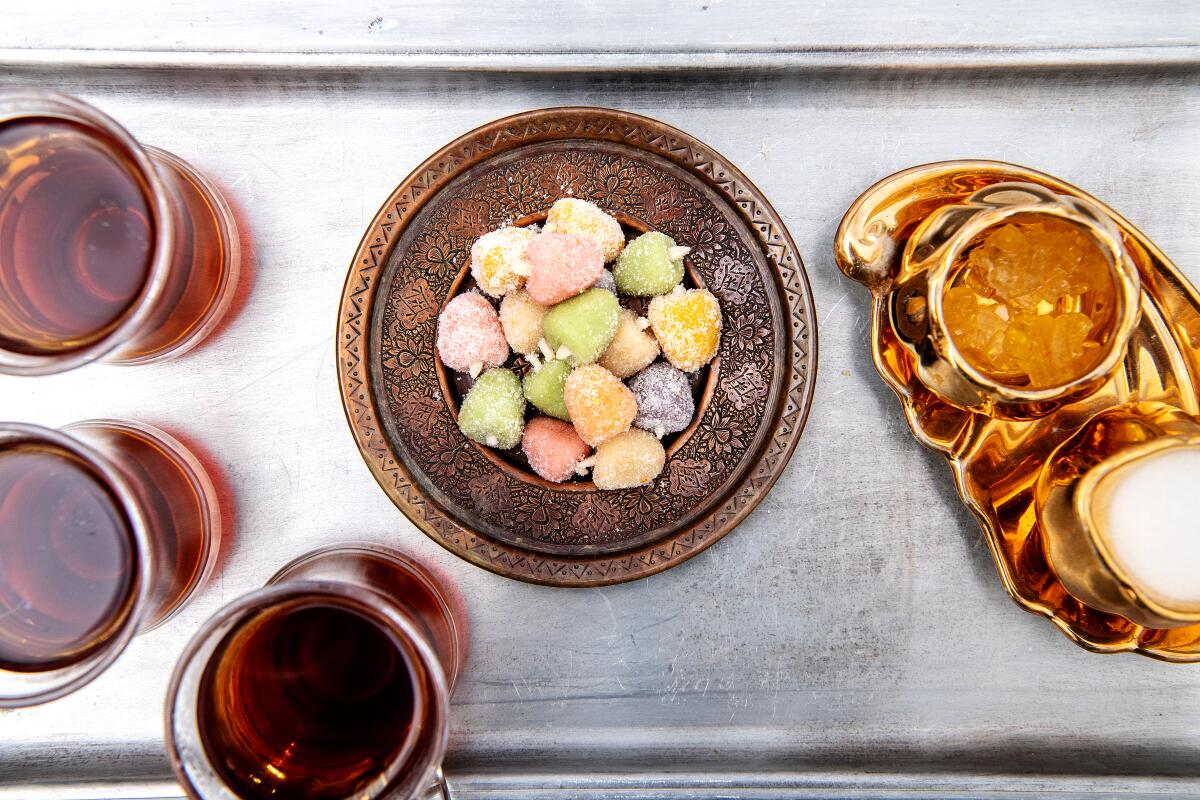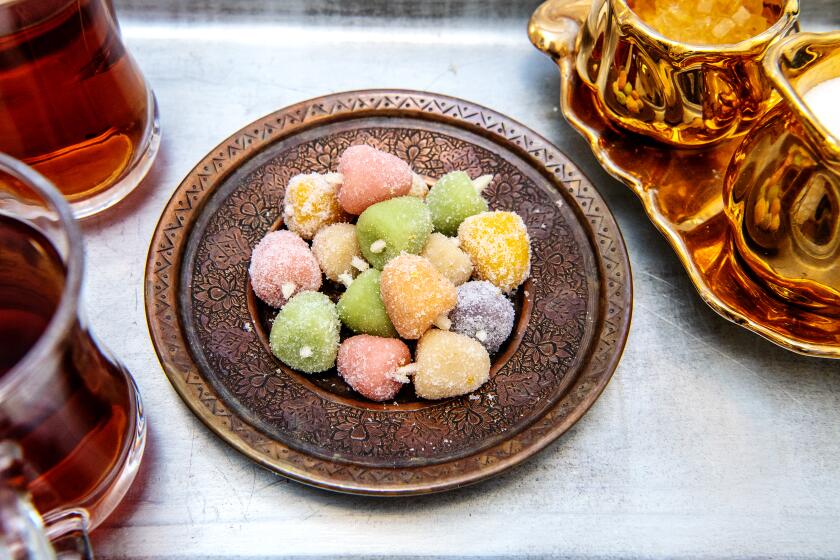Sweets for a sweeter Iranian new year

- Share via
The golden glow of late afternoon light washes over Fariba Nafissi’s Simi Valley bakery, ZoZoBaking Studio, flickering its way across her Sofreh Haft Seen, the traditional Nowruz (Iranian new year) tablescape, or cloth, decorated with seven symbolic items starting with the Persian letter S (pronounced as “seen”). The light briefly spotlights each item and reflects off the sugar-dusted toot — mulberry-shaped Iranian marzipan — providing a display of kaleidoscopic patterns and lights.
It’s another reminder that Nowruz is just around the corner.
Nowruz (which means “new day”) is a secular and ancient celebration of the vernal equinox marking the first day of spring in the Northern Hemisphere and the start of the new year. This year Nowruz falls on March 20, at 2:37 a.m. Pacific time — the moment when the length of day and night are almost equal.
Nowruz celebrations last 13 days, beginning with the first day of spring and culminating with a picnic, but preparations begin well in advance. “It would start with the khooneh takooni (also known as khaneh takani) and of course all the baking,” Nafissi says, fondly recalling her childhood family traditions in her hometown of Kerman, Iran.
Khaneh takani, which translates to “shaking out the house,” refers to the Iranian tradition of cleaning and cleansing the home in preparation for the new year. Once all the windows are washed, rugs are beaten and cabinets are cleared and reorganized, the ritual of baking Nowruz pastries begins. In the weeks leading up to the holiday, the scents of rose water, orange blossom water and cardamom permeate the air inside Iranian home kitchens and Iranian bakeries, including ZoZoBaking Studio.
Nafissi opened her bakery in September 2019. She already had a successful online shop but wanted to open a physical space where people could gather and feel at home, as if they were joining her for an Iranian pastry and a cup of tea or Turkish coffee right in her living room. After a busy few months the studio, like many other establishments, had to close its doors to indoor gatherings in March 2020, but orders can be placed online. Nafissi is hopeful she can return to hosting all her regular and new customers at the bakery soon.
In the meantime, there’s more to be done in anticipation of Nowruz.

The seven items on the Sofreh Haft Seen include sabzeh (wheat, lentil or mung bean sprouts), samanu (a sweet pudding made with germinated wheat), seeb (apple), senjed (the dried fruit of the wild olive, oleaster), somagh (sumak), serkeh (vinegar) and seer (garlic). Various pastries are placed on the table as a symbol of sweetening the year to come. Common ingredients include flower waters and warm spices like cardamom, almonds and pistachios (used both whole and ground to a powder), chickpea flour, rice flour and, of course, plenty of sugar. (Blanched ground almonds are also the main ingredient in toot, which means mulberry in Persian.)
Iranian baghlava, one of the stars of Nowruz sweets (and popular at ZoZoBaking), is prepared in advance in large sheet pans or round tins and shared with family and friends. Whereas baklava from neighboring countries is made with a flaky phyllo pastry, Iranian baghlava uses a softer dough that is rolled out very thin and filled with blanched ground almonds or pistachios. And the Sofreh Haft Seen would be incomplete without naan-e nokhodchi, the melt-in-your-mouth chickpea flour cookies shaped like a clover, and naan-e berenji, delicate rose-scented rice flour cookies. Nafissi also includes her beautiful signature date-filled cookies called kolompeh on her table.
As Nafissi talks, she surveys her bakery and the stacks upon stacks of turquoise pastry boxes waiting to be filled with the jewel-like mix of her Nowruz cookies. The fading light casts a final soft glow on a framed black-and-white photograph of her mother at the stove, stirring a pot, glancing back with a warm smile.
“My mom would do all the baking for Nowruz, and everybody in the family would get pastries from her. She put her heart in those hands that did all the baking,” Nafissi says, as her voice catches in her throat. “Now I get to give other people the same feeling. I can do the baking, and I can bring a taste of Iran to their homes. I truly think about every family that will receive this box, and I want it to be exactly the same feeling of love I got from my mom.”
Just before ringing in the new year, Nafissi’s family, like many other Iranian families, gathers around the Sofreh Haft Seen. As the clock ticks and a new year is ushered in, kisses and hugs are exchanged, family members wish each other a happy new year, and a fragrant platter of Nowruz pastries is passed around for everyone to sweeten their mouths and welcome spring.
Sweets that carry with them all the love, care and hopes for a sweeter new year.
Get the recipe for Toot (Iranian Marzipan).
Toot (Iranian Marzipan)
More to Read
Eat your way across L.A.
Get our weekly Tasting Notes newsletter for reviews, news and more.
You may occasionally receive promotional content from the Los Angeles Times.











